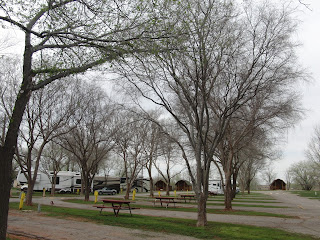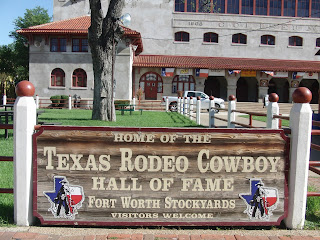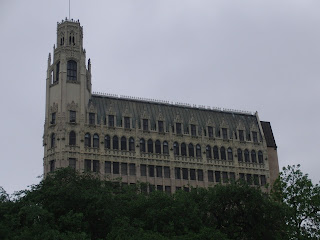Click picture to see larger pictures.
Like geese on their summer migration, we went looking for better weather. This is the KOA RV Park in Elk City, Oklahoma. No blustery winds but still cold. As you can tell by the trees, spring hasn't quite shown herself as yet.
Trish and Murray are from Ballina, a costal town in New South Wales.
Click picture to see larger pictures.
Due to the threat of tornadoes, freezing rain we cut short our stay in Guthrie and left for Arlington, Texas.
This is downtown Fort Worth - gorgeous architecture!
The Fort worth Stockyards Station is worth a visit. It was once the biggest and busiest cattle, horse, mule,hog and sheep marketing center in the SW, where more than 160 million head of livestock were sold.
I guess you could say Texas is the Voldemort of bovines...cows here just don't stand a chance. If the steak restaurants don't get them, there's always the ubiquitous MacDonald's lurking in the background like some ever present common cold virus.
The iconic longhorn cattle of Texas. There are 2 cattle drives a day at the Station. Some info about the longhorns below.
What is the origin of Texas Longhorns?
Unlike most breeds of cattle, no one set out to develop Texas Longhorn cattle as a breed. Instead, they evolved in North America from descendants of cattle brought into the Americas by the Spanish in the late 1400s and early 1500s (the first cattle were brought into Hispaniola in 1493). However, the cattle did not descend directly from Spanish stock. Rather, the first cattle to be imported by the early Spanish explorers were from the Canary Islands. These cattle, in turn, were imported from Portugal, and the closest relatives of Texas Longhorns among existing European breeds are Portuguese cattle breeds (such as the Alentejana and Mertolenga). These early imports of Iberian cattle from the Canary Islands soon became feral in northern Mexico (which included lands that became the Republic of Texas in 1836, and part of the United States in 1845). These wild herds underwent intense natural selection; the only cattle that could survive were highly disease resistant, could live on harsh range conditions (through droughts, floods, heat, and cold), and could defend themselves and their calves against predators.
It was still a pretty chilly day although the sun was out. The Museum provided a nice warm haven.
Check out this armchair made from horns....there was even a little itty bitty one for me.
Click picture to see larger pictures.
Amazing network of highways - everything's bigger in Texas!
Tree Tops RV Village, Arlington, TX - a lovely leafy RV Park. Conveniently located near the Parks at Arlington Shopping Mall - shopping heaven and within walking distance. There is a Super Target just round the corner from the park.
This lovely bush was just outside of our RV.
San Marcos, TX - Day 15 into our trip and we are at Pecan Park Riverside RV Park. Another lovely leafy location with a river running at the back of the park. Popular with rubber tubers - we caught a group of young ones in high spirits (in more than 1 way).
There are mobile cabins scattered through the park (see the one in the background). Cute little squirrels call this park home too.
Nifty little 5th wheel made by Forest River.
Our playing partners, Paul and Mike with Tom, they played American style golf with Mulligans and Gimmies while Tom and I played stroke play Australian style. Unfortunately there was a constant haze shrouding the area whilst we were there. We were told its the annual spring burn off by the Mexicans.
Riverwalk, San Antonio where there are restaurants lining both sides of the man made canal. It would have been a perfect day if not for the haze. Another tourist attraction worth visiting.
We took a boat cruise on the canal which is fed by the waters from the San Antonio river. This city was worth the visit, lots of historical buildings co-existing with modern glass juggernauts.
The Alamo as it stands today - quite a moving place. We almost missed the most important part of this complex - the room where the last of the Texan defenders were killed on March 6, 1836. This is where a short clip of the history of the Alamo is screened. Don, our guide gave a wonderful and entertaining account of the events leading up to the 13 fateful days in 1836.
A grand old tree in the courtyard of the Alamo.
German cathedral in San Antonio. On the I-35 South, we came across towns with names like New Braunfels, Gruene...we were surprised to see the German influence in this State.
Ay Caramba!! I think it means OMG in English. I saw this chica outside the Alamo - there was a boxing ring set up and lots of hoo hah promoting some fight for the coming weekend. They had earsplitting music that even shook the windows of the Alamo building. I don't think you need to click on picture to see this one larger. Hey Norm, Tom here - I took this picture at Betty's request so no wise comments and no it's not Betty's butt although I suspect she wishes it were.
Click picture to see larger pictures.
The Riverwalk restaurants - the canal also serves as a flood control for the city. Interesting to learn the canal is drained annually. Most common item found in the mud...cellphones.
Our captain of the barge that took us around the canal system.
Numerous hotels dot the waterways - a lot of them build to cater for the influx of tourists during the World Fair in 1968.
Lush greenery and flowering shrubs line both sides of the Riverwalk. San Antonio is named after St. Anthony of Padua - there is a statue of St. Anthony along Riverwalk in honour of the city's patron saint.
Brava House, Austin - a charming bed and breakfast place where we spent a night so we could do the nightlife of 6th St. Not cheap at $183.00 per night.





































It was great to catch up with you both in Guthrie. Your San Antonio photos bring back fond memories of our visit there last year. Neat place hey!
ReplyDelete